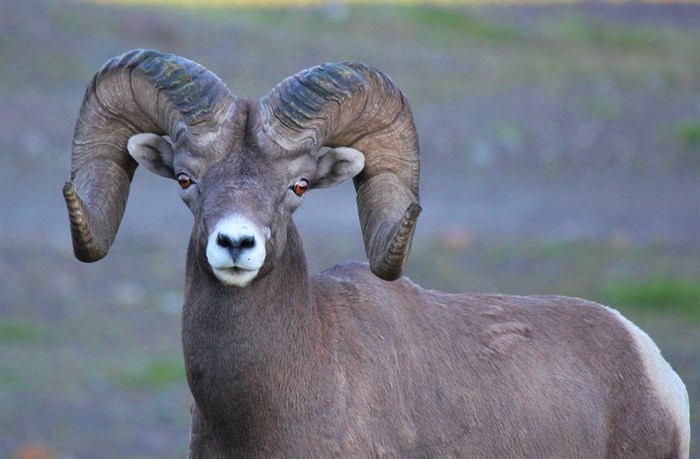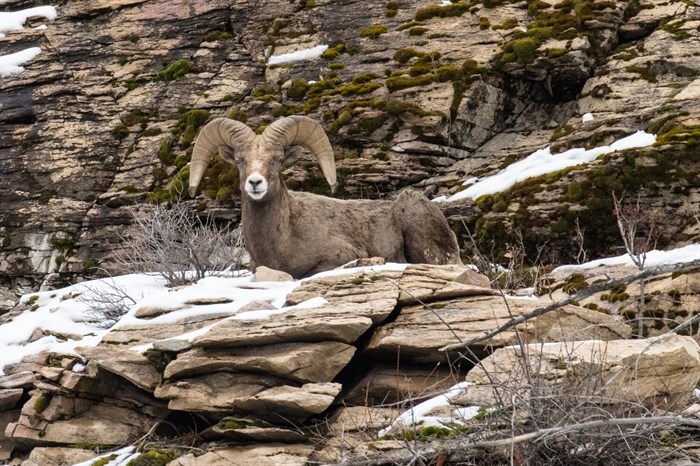
Image Credit: Alberta Fish and Wildlife
December 24, 2023 - 7:00 PM
EDITOR’S NOTE: Since this story's publication, iNFOnews.ca has been notified by the Okanagan Similkameen Stewardship that some of the information provided for the article was misleading or incorrect. Research in Alberta showed a correlation between trophy hunting and reduced horn size. This impact is not evident in the Okanagan, as the limited entry hunting draw means fewer animals are killed. Preliminary data from the Kootenays has also shown no effect from hunting on bighorn sheep horn size. Corrections have been made to the story and the headline has been changed to better reflect the story and has been filed in corrections. The story remains on site for full transparency.
Bighorn sheep may be one the Okanagan’s most well-known wildlife residents. However, as time goes on, could they be at risk of losing their most defining characteristic?
Bighorn sheep are known for their large, crescent moon horns. Unfortunately, this distinct feature also makes them vulnerable to trophy hunting across Canada.
“Hunters continually select the largest horns and the biggest rams,” Lia McKinnon, Stewardship Biologist for the Okanagan Similkameen Stewardship, told iNFOnews.ca.
Males use their horns to display strength in head butting fights during mating season. Inside, the horns have a honeycomb structure, McKinnon said, which helps create padding for the brain when the sheep clash.
Because their horns are smooth, these altercations are not typically fatal like fights during the deer ruts. However, as they like to hang around cliffs, there can be nasty accidents.
Research from the University of Sherbrooke showed that intense trophy hunting of rams in Alberta led to a reduction in horn length through evolutionary change. Hunting of the “full curl” rams in this region created a selective pressure for sheep to have smaller horns.
While trophy hunting is legal in BC, it is restricted by a limited entry draw. So far, this restrictive policy has saved the Okanagan's sheep from shrinking their most defining feature.
According to Alyson Skinner, Executive Director of the Okanagan Similkameen Stewardship, preliminary data from the Kootenays has shown no effect from hunting on bighorn sheep horn size.
While their majestic horns might be safe in British Columbia, the species' numbers are declining in the Okanagan.
According to the Wild Sheep Society of British Columbia, the South Okanagan saw a 30% decline in bighorn sheep populations between 2020 and 2022.
Big horn sheep live throughout the Okanagan Valley, although more often than not they can be spotted hanging close to cliffs with their young.

Vaseux Lake Big Horn Sheep
Image Credit: Barry Scully
“They do climb like mountain goats, so they really like to have cliffs around,” McKinnon said. “It’s called escape terrain because they're slower than predators on open ground, but along cliffs and really steep slopes they're very fast.”
Bighorn sheep are herbivores and eat a wide range of grasses, plants and shrubs. They are also part of the diet of a number of local predators, including cougars and coyotes.
These sheep are considered a species at risk in British Columbia, their main threat being diseases transmitted by domestic sheep, goats and possibly llamas.
“A huge problem in the past, that has killed a lot of our bighorn sheep, is a pneumonia,” McKinnon said. “The BC Government is introducing some legislation which is going to require domestic sheep farmers to test for the bacteria. Because you can actually manage your domestic sheep herds in such a way that you can get rid of (the bacteria), which then completely gets rid of the risk to the bighorn sheep as well.”
Sarcoptic mange is another recent threat to the sheep. The mange, caused by a mite, is making its way up the Okanagan Valley and causing problems for local herds.
The Okanagan Similkameen Stewardship works to protect locally at-risk species like bighorn sheep by helping private landowners preserve and enhance habitat on their properties.
The organization works on restoration of public land and frequently provides educational presentations for the local community.
More information about the Okanagan Similkameen Stewardship can be found on their website here.
To contact a reporter for this story, email Georgina Whitehouse or call 250-864-7494 or email the editor. You can also submit photos, videos or news tips to the newsroom and be entered to win a monthly prize draw.
We welcome your comments and opinions on our stories but play nice. We won't censor or delete comments unless they contain off-topic statements or links, unnecessary vulgarity, false facts, spam or obviously fake profiles. If you have any concerns about what you see in comments, email the editor in the link above. SUBSCRIBE to our awesome newsletter here.
News from © iNFOnews, 2023